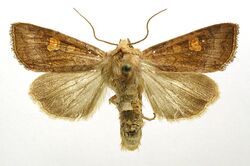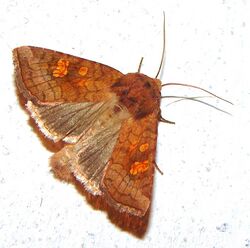Biology:Amphipoea lucens
| Amphipoea lucens | |
|---|---|

| |

| |
| Scientific classification | |
| Domain: | Eukaryota |
| Kingdom: | Animalia |
| Phylum: | Arthropoda |
| Class: | Insecta |
| Order: | Lepidoptera |
| Superfamily: | Noctuoidea |
| Family: | Noctuidae |
| Genus: | Amphipoea |
| Species: | A. lucens
|
| Binomial name | |
| Amphipoea lucens (Freyer, 1845)
| |
| Synonyms | |
| |
Amphipoea lucens, the large ear or large ear moth, is a moth of the family Noctuidae and is found in most of Europe. It was first described, in 1845, by the German entomologist, Christian Friedrich Freyer, from a specimen, found in Berlin. The larva feed on the roots and stems of grasses.
Description
The wingspan is about 30–36 mm. It resembles the ear moth (Amphipoea oculea), but is larger, with the ground colour, as a rule, pale and the reniform white. Adults are on wing from August to September and come to flowers, especially rushes and also comes to light.[1][2]
The larvae feed from May to July, at first within the lower stems and later among the roots of purple moor-grass (Molinia caerulea) and common cottongrass (Eriophorum angustifolium). Pupation takes place on the ground in the leaf litter and the moth overwinters as an egg.[2][3][4]
Similar species
Requiring genitalic examination to separate, See Townsend et al.,[5]
- Crinan ear (Amphipoea crinanensis)
- ear moth (Amphipoea oculea)
- saltern ear moth, (Amphipoea fucosa)
Taxonomy
Freyer, when describing the moth, placed it in the genus Apamea, which was raised by the German entomologist and actor, Ferdinand Ochsenheimer in 1820. Apamea is the name of a several towns in Asia Minor and has no entomological relevance. It was later placed in the genus Amphipoea which was raised by the Swedish anatomist Gustaf Johan Billberg in 1820. Amphipoea refers to Amphi – round and poa – grass; i.e. the habitat. The specific name, lucens means gloss or shining, referring to the bright mark on the forewing (i.e. the reniform stigma – the ear in the English name). Another possibility, is the gleam of the resting moth near a lantern, as it would be seen by collectors.[6]
References
- ↑ Kimber, Ian. "73.127 BF2357 Large Ear Amphipoea lucens (Freyer, 1845)". https://ukmoths.org.uk/species/amphipoea-lucens/.
- ↑ 2.0 2.1 Goater, Barry (1983). Heath, John; Emmet, A Maitland. eds. Amphipyrinae. In The Moths and Butterflies of Great Britain and Ireland. Volume 10. Colchester: Harley Books. pp. 234-5. ISBN 0-946589-01-1.
- ↑ Robinson, Gaden S.; Ackery, Phillip R.; Kitching, Ian J.; Beccaloni, George W.; Hernández, Luis M.. "Search the database – introduction and help". Natural History Museum, London. https://www.nhm.ac.uk/our-science/data/hostplants/.
- ↑ Henwood, Barry; Sterling, Phil (2020). Field Guide to the Caterpillars of Great Britain and Ireland. London: Bloomsbury Publishing. p. 314. ISBN 978-1-4729-3358-4.
- ↑ Martin C. Townsend, Jon Clifton and Brian Goodey (2010). British and Irish Moths: An Illustrated Guide to Selected Difficult Species. (covering the use of genitalia characters and other features) Butterfly Conservation.
- ↑ Emmet, A Maitland (1991). The Scientific Names of the British Lepidoptera. Their History and Meaning. Colchester: Harley Books. p. 213 & 216. ISBN 0 946589 28 3.
External links
- Savela, Markku. "Amphipoea lucens (Freyer, 1845)". https://www.nic.funet.fi/pub/sci/bio/life/insecta/lepidoptera/ditrysia/noctuoidea/noctuidae/xyleninae/amphipoea/#lucens. Retrieved June 28, 2019. Taxonomy
- Lepiforum e.V. Includes photo of genitalia
- De Vlinderstichting (in Dutch)
Wikidata ☰ Q2409933 entry
 |

